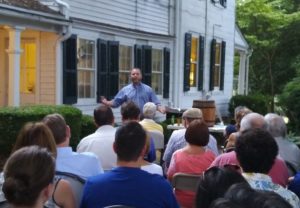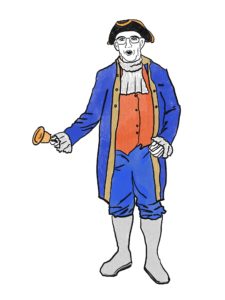The 1918 flu epidemic was the subject of the presentation of the Historical Society of Moorestown’s very own president, Mickey DiCamillo, on Wednesday evening, July 11, outdoors on the Smith-Cadbury patio. Attendees were treated to cookies, lemonade, and iced tea.
Mickey kept the sold-out crowd of 30 spellbound in explaining the origins of the flu and why it socked the Philadelphia area, in particular, with such a lethal punch. He said that, at first, the belief was that soldiers brought the flu back with them from overseas. Then, a theory gained some currency that German POWs brought the disease with them from England, and that the Germans, in turn, had acquired it from Russian soldiers. Later, during the Cold War, the whole thing was blamed on the Soviets. A popular theory also had the flu emanating from Spain – hence, the name,” Spanish influenza.”
Today’s prevailing view, said Mickey, is that it started on a Kansas farm in February 1918. Wild birds carrying a version of the flu would have infected domesticated birds, which transmitted it to pigs, and then it was a matter of time before it reached humans. Normally healthy people became infected, developed the flu, which turned into pneumonia, and then died. The flu made its way to Camp Funston, near Manhattan, Kansas. People theorize that soldiers sent to France from the Camp brought the disease with them.
In the fall of 1918, the flu appeared at Camp Dix in New Jersey, which led to the terrible Philadelphia outbreak that culminated in 16,000 deaths in the region. Moorestown’s own “Tommy the Barber,” stationed at Camp Dix, witnessed the swift death of many soldiers. It began, he said, with severe head pain and dizziness, with back pain developing as well as the expected sore throat. Then it reached the lungs of the men, which quickly filled up with fluid. They died a death similar to drowning.
When in the fall the disease began showing up in Philadelphia, it ripped through the city and the suburbs within a matter of days. Its rapid transmission was facilitated by the day’s lack of familiarity with the spread of germs, while about 75% of all medical personnel in the United States was overseas in the war. A conflict ensued between two priorities: keeping the war going versus shutting everything down.
Mickey said that local authorities permitted a giant Liberty Loan Parade in Willow Grove Park to go on as planned. It attracted a massive audience of 200,000. With so many people packed in a limited space, the disease had no trouble infecting a maximum number of individuals. By the end of September 2018, thousands of people in the area were coming down with the flu, and quickly dying.
Eventually, Philadelphia officials realized that they needed to prevent large groups from gathering, and decreed the indefinite closure of churches, social clubs, lodges, and, before long, bars and saloons. Philadelphians deprived of their whiskey traveled to Camden and Gloucester City saloons, with New Jerseyans shocked and disturbed by this influx of rowdies. New Jersey soon made the controversial decision to shut down saloons statewide.
When the disease finally ran its course, an estimated 50 million people had died across the globe.
Thanks to everyone who attended the Historical Society’s first summertime talk!
-Liz Rosenthal





